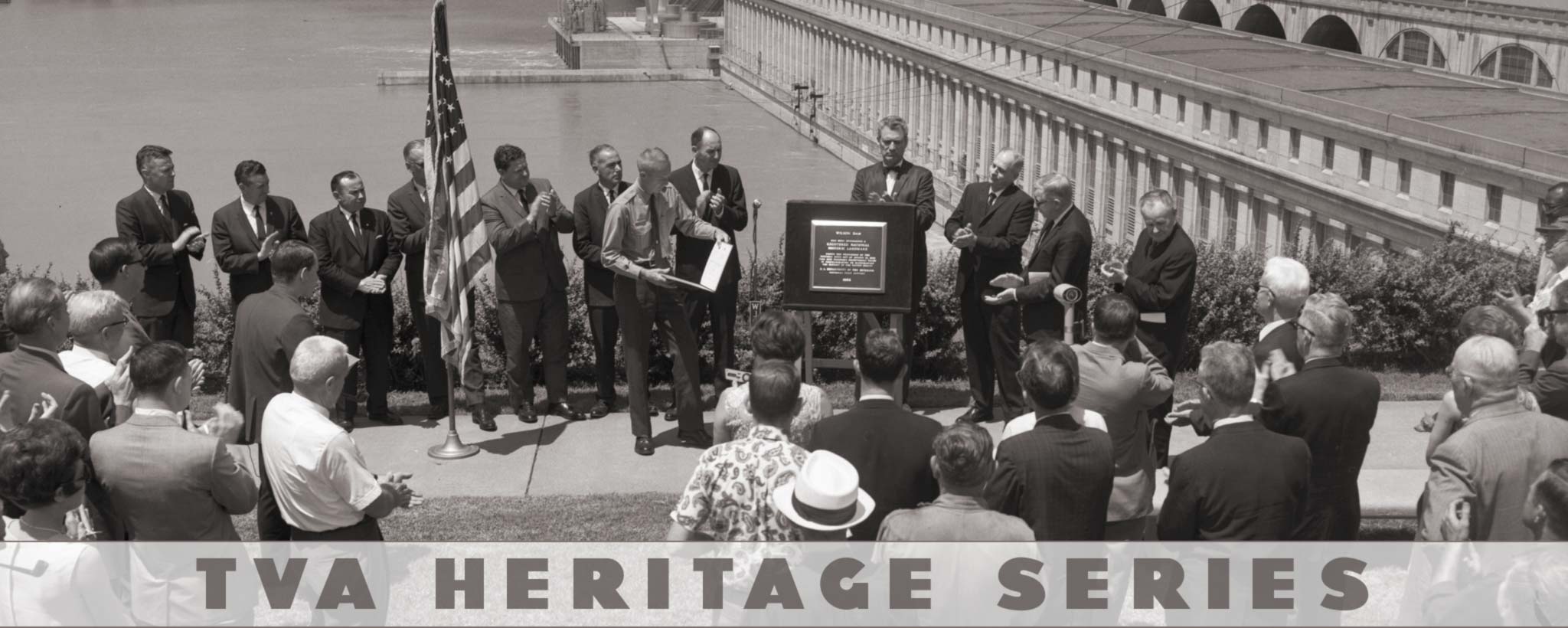
TVA Treasure
By all accounts, May 18, 1967, was a beautiful day in Muscle Shoals, Alabama. A small crowd, made up of TVA and National Park Service representatives; state and local officials; and history enthusiasts gathered on the south bluff overlooking Wilson Dam to witness the Department of the Interior designating TVA’s most powerful hydroelectric facility a National Historic Landmark.
TVA Chairman A. J. “Red” Wagner received a bronze plaque giving Wilson Dam its recognition, which came on the 34th anniversary of the creation of TVA. Wagner used the moment to remind those assembled that it was during World War I that Congress decided to build the dam to use the power and resources of the Tennessee River for the national defense. Wagner said the act of Congress creating TVA “signaled an historic move toward multi-purpose river development.” In his remarks, he also noted that the same dam and reservoir that would produce electric power would also overcome the Muscle Shoals, “the great barrier that had always thwarted man's efforts to navigate the Tennessee River."
National Historic Landmark or National Register of Historic Places?
Today, 29 of TVA’s hydroelectric projects are listed in the National Register of Historic Places (NRHP), but only one of those, Wilson, is designated a National Historic Landmark (NHL). What’s the difference between the two designations?
The NRHP is the official list of the Nation’s historic places worthy of preservation. There are more than 95,000 properties listed as NRHPs, with many of these being important to their local communities. For example, Ayres Hall at the University of Tennessee, Knoxville, is listed in the NRHP. Ayres is important to the story of education in the state of Tennessee and to Knoxville’s account of its municipal development, but the building is not important on a national level.
NHL designations, on the other hand, are those places that hold national significance. There are about 2,600 NHLs, and the Secretary of Interior designates these places as exceptional because of their abilities to illustrate U.S. heritage. NHLs include such diverse properties as the United States Capitol Building, Sun Record Company in Memphis, the Perryville Battlefield in Kentucky and the Moundville Archaeological Site in Alabama.
Wilson as a National Historic Landmark
A few days before the official NHL ceremony was held at Wilson, the Honorable Robert E. Jones of Alabama addressed his colleagues in the House of Representatives, highlighting TVA’s role in realizing the potential of the “mighty Tennessee River,” and in TVA’s contributions to the general advancement of this country.
Jones went on to enter into the record an editorial that had been published in the Florence Times under the title, “Looking Forward with TVA.” While lauding the achievements of TVA, the author put Wilson Dam in national perspective:
Wilson Dam, completed in 1924 by U.S. Engineers, sparked the great TVA and factory complex in the Muscle Shoals area. Then the world’s largest dam, it formed the nucleus for the Authority’s great program of power, flood control and navigation. This great dam will become a National Historic Landmark on TVA’s 34th birthday on May 18th as well it should. Modernized with the world’s highest single lift lock and generating more than twice the power of Niagara Falls, this great monolith stands as a monument to man’s imagination and ingenuity. It is not the largest dam in the world today. There are several larger and higher but to the people of Muscle Shoals, who remember the long struggle to save the dam and plants from the scrap heap, Wilson Dam will always be the greatest.
Read more about Wilson Dam in our historical overview, A Dam for the People.